John J. Pershing and the American Expeditionary Forces in World War I, 1917-1919 by Greenwood John T.;

Author:Greenwood, John T.;
Language: eng
Format: epub
Publisher: University Press of Kentucky
Published: 2021-08-15T00:00:00+00:00
Wilgus himself, the acknowledged architect to the AEFâs entire railway transportation system, explained how he developed his estimates, which were embodied in cable P-42-S and Requisition No. 6:
Hasty studies were also made of what would be needed in the way, not only of port materials, but also of track materials, water supply, cranes, tools and appliances, locomotives, cars, engine houses, shops and many other items essential to the creation, improvement, and operation of the French standard gauge railroads between the ports and the railheads at the front, of standard and narrow gauge military railway in the Zone of the Armies, and of storage depots, regulating stations and other facilities that would be used exclusively by the Americans. This necessarily had to be a leap in the dark. No inspection of the proposed American lines of communication and of the ports operated by the British in northern France had yet been made, although the needed consent to do so had been repeatedly requested by the author; ⦠; nothing definite was known as to the extent to which the American Army would be called upon to provide its own locomotives and cars; no one in the Army to whom the author had access would assume the responsibility of saying how large an army should be planned for within a given time, how much it would consume, or where it would fight. Nevertheless, at the suggestion of Captain Barber, the die was cast when a bill of materials, predicated on a rough estimate of the possible volume, sources and distribution of traffic ⦠was hurriedly made by the author and incorporated by him in what was known as Requisition Number Six bearing the date of July 14, 1917 [encapsulated in cable P-42-S above as modified by P-73-S, July 31]. In this, and in the cablegrams that made it effective, provision was made for an initial stock of material for an army of 500,000 men, to be delivered by February 1, 1918, plus a six monthsâ additional supply; and also for monthly increments that were to follow automatically, all to be proportionately increased for a larger army. It proved to have been a wise move, as all that the Army ever received in satisfaction of many, if not most, of its needs in these respects, up to the Armistice, was what was ordered in this initial requisition. (Wilgus, Transporting the AEF in Western Europe, pp. 18â19. A copy of Requisition No. 6 is at Appendix A, pp. 563â71.)
Download
This site does not store any files on its server. We only index and link to content provided by other sites. Please contact the content providers to delete copyright contents if any and email us, we'll remove relevant links or contents immediately.
The Radium Girls by Kate Moore(10914)
The Templars by Dan Jones(4192)
100 Deadly Skills by Clint Emerson(4084)
Rise and Kill First by Ronen Bergman(4017)
The Doomsday Machine by Daniel Ellsberg(3736)
The Rape of Nanking by Iris Chang(3525)
Killing England by Bill O'Reilly(3459)
Hitler in Los Angeles by Steven J. Ross(3444)
Stalin by Stephen Kotkin(3089)
12 Strong by Doug Stanton(3059)
Hitler's Monsters by Eric Kurlander(2736)
Darkest Hour by Anthony McCarten(2650)
Blood and Sand by Alex Von Tunzelmann(2611)
The Art of War Visualized by Jessica Hagy(2416)
Hitler's Flying Saucers: A Guide to German Flying Discs of the Second World War by Stevens Henry(2299)
The Code Book by Simon Singh(2217)
The Second World Wars by Victor Davis Hanson(2136)
Babylon's Ark by Lawrence Anthony(2073)
Tobruk by Peter Fitzsimons(2064)
